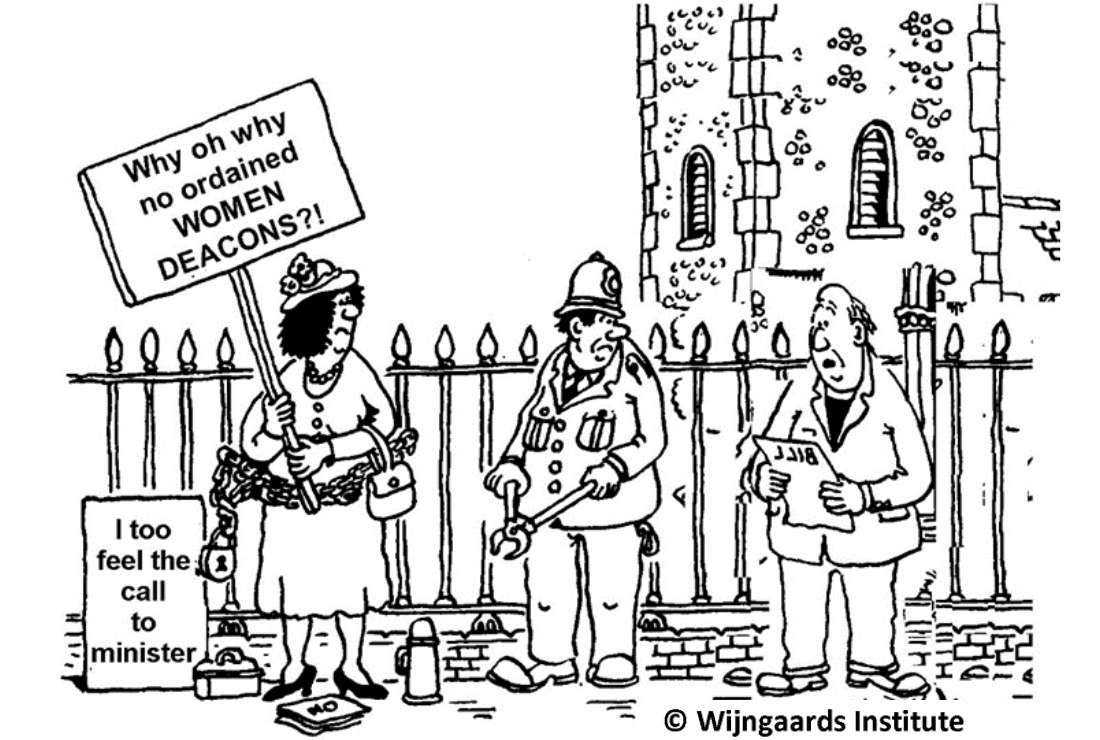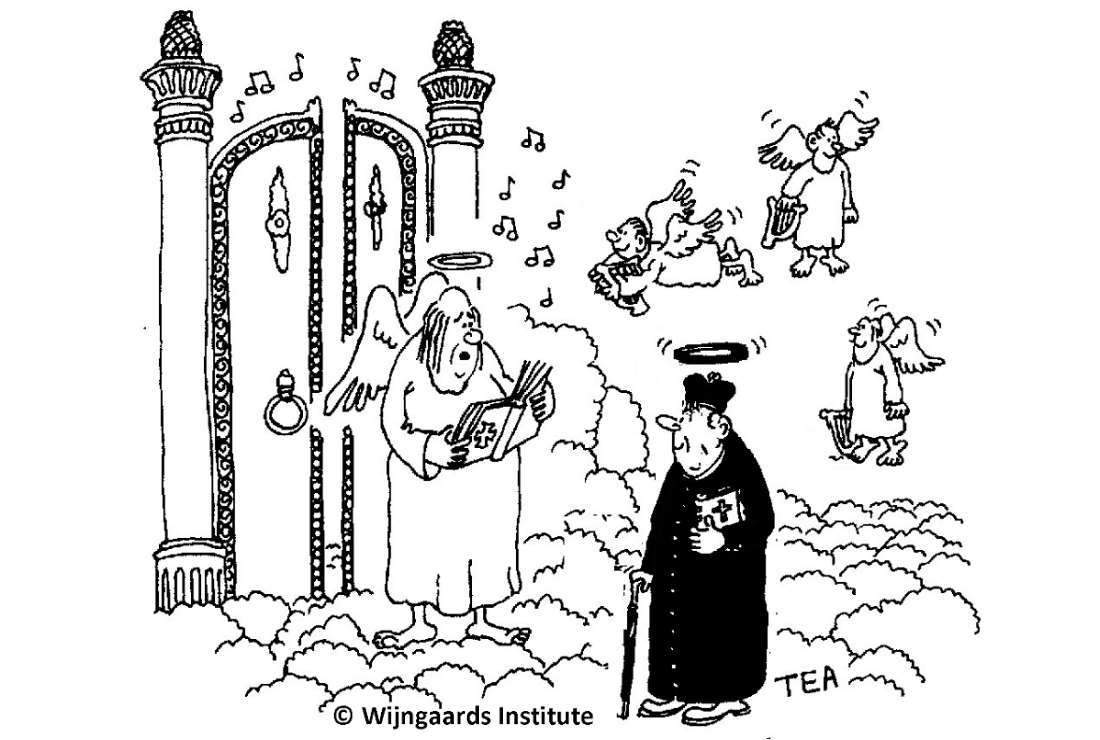Why is the Church still reluctant to ordain women as deacons in spite of the overwhelming evidence to their validity?

"Please, leave her! At least here she's far from my pulpit!" (Illustration Tom Adcock)
“The Twelve were with him, and also some women who had been cured of evil spirits and diseases: Mary (called Magdalene) from whom seven demons had come out; Joanna the wife of Chuza, the manager of Herod’s household; Susanna; and many others. These women were helping to support them out of their own means” (Luke 8,1-4).
In the 1980’s, as Vicar-General of the Mill Hill Missionaries, I visited one of our members. He had served in Kenya for a while. On his return he had been entrusted with a rural parish in the North of England.
After lunch he told me that he had to conduct a meeting for auxiliaries in that region. One way of collecting funds for the missions was for Catholic families to keep a ‘mission box’ in their home in which they themselves or friends could deposit coins when occasions arose. Auxiliaries, mainly women, volunteered to collect these mission boxes every so many months. They would open them, count the contents, send the proceeds to a central account and return the mission boxes to their various homes.
“I try to make these meetings worthwhile”, he told me. “Would you be prepared to come along and give them a little pep talk?”
I said I would.
When my turn came at the meeting, I talked to the group about the need for the Church to re-instate the diaconate for women. I narrated how ordained women deacons had ministered in the East and West during the first millennium and how their service was, regretfully, discontinued mainly because of fear that women during their periods might contaminate the sacred space surrounding the altar.
The response of the women stunned me. Though some were pleasantly surprised and supportive, a large group voiced fierce opposition. “You’re contradicting the pope!”, one shouted at me. “He’s infallible. You are not!”
When I discussed this with the priest later, back in his house, he sighed. “You have no clue of how traditional some priests are in this area”, he said. “Recently, at a deanery meeting, when the idea of a woman reading Scripture or even preaching was raised, one parish priest declared: ‘I will never tolerate a womb, imagine a womb?, in my pulpit!’ …”
Do I need to say more?
Women Deacons
The first seven deacons ordained by the Apostles were all men. But soon also women became deacons. Paul says: “I commend to you our sister Phoebe, a deacon [= diakonos] of the church in Cenchreae. I ask you to receive her in the Lord in a way worthy of his people and to give her any help she may need from you, for she has looked after many people, including myself” (Romans 16,1-2).
1 Timothy 3,8-13 mentions both male and female deacons. “Deacons (male) must be reliable etc. … (vs. 8-10). In the same way, the women (female deacons) are to be worthy of respect, not malicious talkers but temperate and trustworthy in everything (vs. 11). A deacon (male) must be faithful to his wife and must manage his children and his household well (vs. 12). Those who have served as deacons [diakonisantes = both male and female] with distinction will achieve a high status and great assurance in their faith in Christ Jesus” (vs. 13).
We have abundant evidence about female deacons from Church fathers, historical records and tombstones. We have texts of the ordination rite for women deacons from the 3rd century. They show that the rite was substantially identical to that of male deacons and fully sacramental.
What would Jesus have said about this development?
Foreshadowed in the Gospels
Jesus did not explicitly deal with the diaconate. It was the Apostles who established it as a separate sacramental ministry (Acts 6,1-6). We can be sure they knew this was the kind of thing Jesus would have wanted, for women as well as for men.
We find also women among the disciples who traveled with Jesus. “The Twelve were with him, and also some women who had been cured of evil spirits and diseases: Mary (called Magdalene) from whom seven demons had come out; Joanna the wife of Chuza, the manager of Herod’s household; Susanna; and many others. These women were helping to support them out of their own means” (Luke 8,1-4). Notice that these were practical women.
- Mary of Magdala stood under the cross when Jesus was crucified giving support to Jesus’ mother (John 19,25-26). She made sure to note where Jesus was buried (Mark 15,47). On Easter morning she went to Jesus’ tomb to anoint his body and became one of the first witnesses of the resurrection (John 20,1-18).
- Joanna came from a family of managers. Her husband oversaw the domestic arrangements in the palace of Herod Antipas. She accompanied Mary of Magdala to help her anoint Jesus’ body.
Then we have the story of Mary and Martha. Martha is obviously running the show. She invites Jesus into their home. She provides food, drink and other facilities to Jesus and his Apostles. She was obviously keen to listen to Jesus’ teaching, but when her sister Mary, sitting at Jesus’ feet, leaves the hospitality service to her alone, she objects. Jesus gives her a gentle rebuke: “Martha, Martha, you are worried and distracted by many things; but only one thing is necessary. Mary has chosen the better part, which shall not be taken away from her” (Luke 10,38-42).
Another story of Mary and Martha occurs in John’s Gospel (John 11,1-44). They are sisters of Jesus’ friend Lazarus. Probably they are the same persons mentioned earlier by Luke. When Lazarus dies, Jesus goes out of his way to visit them. Again it is Martha who takes the lead. While Mary stays in the house, Martha runs out to meet Jesus. Responding to Jesus she expresses her faith three times:
- “If you had been here, my brother would not have died” (vs. 21).
- “I know my brother will rise again in the resurrection at the last day” (vs 24).
- And to Jesus’ words ‘I am resurrection and life’, she replies: “I believe that you are the Messiah, the Son of God, who is to come into the world” (vs. 27).
After having called her sister Mary, Martha then leads Jesus to the tomb in which Lazarus had been buried four days earlier. The stone in front of the tomb was removed. Jesus calls Lazarus out. And he comes out, still wrapped in funeral linen — but again fully alive.
It is obvious that Jesus accepted such competent women who both provided valuable service (diakonia) and who possessed exemplary faith.
Questions
Why are Church authorities still reluctant to ordain women as deacons — in spite of all the overwhelming evidence to their validity?
Why deprive Catholic communities of the leadership and service that such women could provide?
Published by arrangement with the Wijngaards Institute for Catholic Research
*The views expressed in this article are those of the author and do not necessarily reflect the official editorial position of UCA News.










